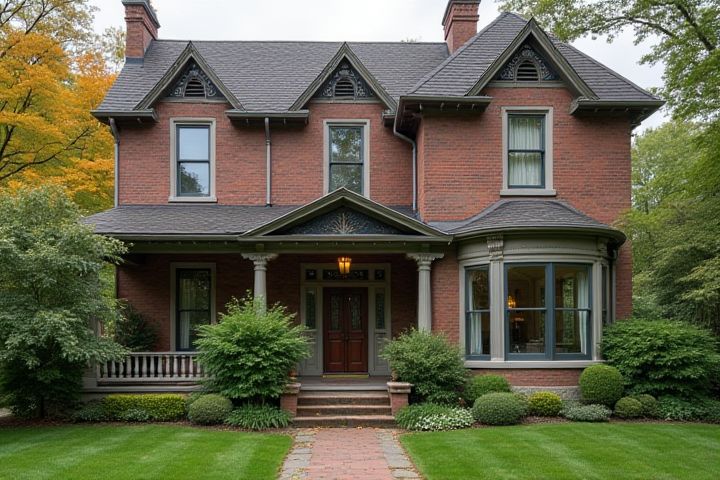
Maintaining a historic house involves regular inspections of key structural components like the roof, foundation, and walls to identify and address any signs of wear or damage. It's important to use historically accurate materials for repairs, as modern substitutes may not provide the same aesthetic or functional qualities. Regular cleaning of exterior surfaces, including gutters and windows, helps prevent water damage and deterioration. You should also tend to the landscaping, ensuring that any trees or plants do not compromise the structure or drainage system. Preservation of original features, such as moldings, hardware, and flooring, is essential for maintaining the historical integrity and charm of the property.
How To Maintain A Historic House
Preserve original features.
To successfully preserve original features of a historic house, prioritize an inspection of structural elements such as moldings, windows, and doors, aiming for a restoration rather than replacement. Utilize period-appropriate materials, emphasizing wood types and finishes that align with the home's architectural style, which can enhance authenticity. Regular maintenance schedules, such as repainting with historically accurate colors every 5-7 years, help protect these features from deterioration. Finally, document any restoration work to maintain a clear history of alterations and repairs, ensuring your home reflects its unique historical narrative.
Regularly inspect structure.
Regular inspections of a historic house's structure are crucial to preserving its integrity and charm. Examine key elements such as the foundation, roofing, and framing for any signs of wear, damage, or moisture intrusion, ideally conducting these checks every six months. Pay particular attention to windows and doors, as they can be prone to warping or rot, which may necessitate specialized restoration techniques. Keeping a detailed log of findings, repairs, and maintenance actions can help you track the house's condition over time and ensure it remains a cherished part of history.
Use period-appropriate materials.
Using period-appropriate materials is essential for maintaining the authenticity of a historic house. For example, if your home dates back to the 1800s, opt for original materials like hand-hewn timber, lime-based plaster, or wrought iron fixtures, which were common during that era. Utilize reclaimed wood or vintage bricks to preserve the architectural integrity while decreasing environmental impact. Ensuring that repairs or renovations align with the original construction techniques can significantly enhance your home's historical value and character.
Repair instead of replace.
Repairing rather than replacing elements of a historic house can preserve its authentic character and craftsmanship. For example, restoring original windows can enhance energy efficiency while maintaining historic accuracy, potentially saving homeowners up to 30% in heating costs. Regularly inspecting roofing and siding can prevent small issues from escalating into costly repairs, with routine maintenance expected to extend their life by 20 years or more. Using period-appropriate materials and techniques is crucial; this approach not only honors the home's heritage but can also increase property value by preserving its historical significance.
Maintain historical accuracy.
To maintain historical accuracy in a historic house, begin by researching its original architectural style, period features, and materials using resources like archives and expert consultations. Ensure that restoration materials align with the historic fabric, opting for authentic woods, paints, and finishes that reflect the era of the house, often requiring a budget of 10-30% more than modern substitutes. Implement routine inspections at least twice a year to assess the integrity of structural elements, including roofs, walls, and foundational supports. When renovating, preserve original layouts and features, often constructing a meticulous inventory of the house's original artifacts, which can account for both aesthetic appeal and historical value.
Keep moisture levels balanced.
Maintaining balanced moisture levels in a historic house is crucial for its preservation. Aim for indoor humidity levels between 30% and 50%, which helps prevent mold, mildew, and structural damage. Invest in dehumidifiers or humidifiers as needed, and monitor using a hygrometer to ensure levels stay within this range. Regularly inspect windows, roofs, and foundations for leaks or water intrusion, as addressing these issues proactively will protect the integrity of your historic home.
Hire specialized craftsmen.
Hiring specialized craftsmen is essential for maintaining the integrity of a historic house. Experts such as masons, carpenters, and restoration artisans possess the skills needed to preserve original features while ensuring structural integrity. Consider allocating a budget of 10-15% of the property's value for skilled labor, which can significantly enhance longevity and authenticity. Prioritize craftsmen with proven experience in historic restoration, and request references or portfolios showcasing their previous work to ensure quality and craftsmanship.
Document changes meticulously.
Documenting changes meticulously is crucial for preserving the authenticity of a historic house. Begin by creating a detailed inventory of the property, including original architectural features, materials, and historical significance. Regularly photograph all alterations and repairs, noting dates, processes, and materials used to facilitate future restoration efforts. Maintain a comprehensive logbook that includes contractors, their work, and compliance with local preservation guidelines to ensure your house remains a cherished piece of history.
Stay updated on preservation laws.
Staying informed about preservation laws is crucial for maintaining a historic house, as these regulations can significantly impact restoration efforts and property value. Regularly consult state and local preservation boards or websites for updates on regulations affecting historic properties, which might include tax incentives, grant opportunities, and guidelines for restoration. Joining local preservation societies or online forums can provide real-time information and connect you with experts and other homeowners facing similar challenges. By understanding these laws, you can ensure compliance while enhancing the historical integrity and marketability of your property.
Educate yourself on its history.
Educate yourself about your historic house by researching its architectural style, previous owners, and significant events associated with it. Books, articles, and online resources, such as local historical societies, can provide valuable insights into its past. Attend workshops or lectures to deepen your understanding of preservation techniques relevant to your home. Engaging with preservationists or joining community organizations can also enhance your knowledge and support your efforts in maintaining its historical integrity.
